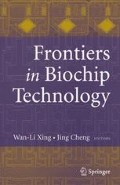Abstract
Microarrays as an emerging research tool promises to play a pivotal role in the post genomic era. However, in spite of the fast development of this technology special requirements, such as the immobilization and delivery of bio-reagents on the chip surface limit the utilization of microarrays, especially for small chemical compound libraries. We have developed a unique homogenous microarray system that overcomes these limitations and can be used to array most biofunctional molecules, such as small chemical compounds, peptides and proteins without pre-immobilization. A standard microscope slide containing up to 5000 microarray dots, with volumes less than 2 nanoliter each and acting as individual reaction centers, can be printed with standard DNA arrayer. An aerosol deposition technology was adapted to deliver extremely small volumes of biofluids uniformly into each reaction center. The fluorescence based reaction signals were then scanned and analyzed with standard DNA scanner and DNA array analyzing software. With this platform, we demonstrated that this chip format could be used for not only screening individual but also multiple enzymatic activities simultaneously with different fluorescent tagged small peptide libraries. We further demonstrated that this system could be a very powerful ultra high throughput screening tool for drug discovery, with which we identified potential “hits” after screening chips printed with small chemical compounds against caspases 1 and 3. This highly sensible chip is also able to monitor caspase protein expression profiles by activating the peptide chips with cell lysates undergoing apoptosis.
Access this chapter
Tax calculation will be finalised at checkout
Purchases are for personal use only
Preview
Unable to display preview. Download preview PDF.
References
Zhu, H., Bilgin, M., Bangham, R., Hall, D., Casamayor, A., Bertone, P., Lan, N., Jansen, R., Bidlingmaier, S, Houfek, T, et al. (2000). Analysis of yeast protein kinases using protein chips. Nature Genetics 26, 283–289.
Zhu, H., Klemic, J.F., Chang, S., Bertone, P., Casamayor, A., Klemic, K.G., Smith, D., Gerstein, M., Reed, M.A. and Snyder, M. (2001). Global analysis of protein activities using proteome chips. Science 293, 2101–2105.
Houseman, B.T., Huh, J.H., Kron, S.J. and Mrksich, M. (2002). Peptide chips for the quantitative evaluation of protein kinase activity. Nat Biotechnol. 20, 270–274.
MacBeath, G. and Schreiber, S.L. (2000). Printing proteins as microarrays for high-throughput function determination. Science 289, 1760–1763.
Kuruvilla, F.G., Shamji, A.F., Sternson, S.M., Hergenrother, P.J. and Schreiber, S.L. (2002). Dissecting glucose signalling with diversity-oriented synthesis and small-molecule microarrays. Nature 416, 653–657.
De Wildt, R.M.T., Mundy, C. R., Gorick, B.D. and Tomlinson, I.M. (2000). Antibody arrays for high-throughput screening of antibody-antigen interactions. Nat. Biotechnol. 18, 989–994.
Nicholson, D.W. and Thornberry, N.A. (1997). Caspases: killer proteases. Trends Biochem. Sci. 22, 299–306.
Lee, D., Long, S.A., Adams, J.L., Chan, G., Vaidya, K.S., Francis, T.A., Kikly, K., Winkler, J.D, Sung, C.M, Debouck, C. et al. (2000). Potent and selective nonpeptide inhibitors of caspases 3 and 7 inhibit apoptosis and maintain cell functionality. J. Biol. Chem. 275, 16007–16014.
Webber, S.E., Tikhe, J., Worland, S.T., Fuhrman, S.A., Hendrickson, T.F., Matthews, D.A., Love, R.A., Patick, A.K., Meador, J.W., Ferre, R.A. et al. (1996). Design, synthesis, and evaluation of nonpeptidic inhibitors of human rhinovirus 3C protease. J. Med. Chem. 39, 5072–5082.
Knezevic, V., Leethanakul, C., Bichsel, V.E., Worth, J.M., Prabhu, V.V., Gutkind, J.S., Liotta, L.A., Munson, P.J., Petricoin, E.F. 3rd, Krizman, D.B. et al. (2001). Proteomic profiling of the cancer microenvironment by antibody arrays. Proteomics 10, 1271–1278.
Thornberry, N.A., Rano, T.A., Peterson, E.P., Rasper, D.M., Timkey, T., Garcia-Calvo, M., Houtzager, V.M., Nordstrom, P.A., Roy, S., Vaillancourt, J.P. et al. (1997). A combinatorial approach defines specificities of members of the caspase family and Granzyme B. J. Biol. Chem. 272, 17907–17911.
Amstad, P.A., Yu, G., Johnson, G.L., Lee, B.W., Dhawan, S. and Phelps, D.J. (2001). Detection of caspase activation in situ by fluorochrome-labeled caspase inhibitors. Biotechniques 3, 608–610.
Talanian, R.V., Quinlan, C., Trautz, S., Hackett, M.C., Mankovich, J.A., Banach, D., Ghayur, T., Brady, K.D., Wong, W.W. et al. (1997). Substrate specificities of caspase family proteases. J. Biol. Chem. 272, 9677–9682.
Garcia-Calvo, M., Peterson, E.P., Leiting, B., Ruel, R., Nicholson, D.W. and Thornberry, N.A. (1998). Inhibition of human caspases by peptide-based and macromolecule inhibitors. J. Biol. Chem. 273, 32608–32613.
Mitchell, P. (2002). A prospective on protein microarrays. Nature Biotech. 20, 225–229.
Morita, T., Kato, H., Iwanaga, S., Takada, K. and Kimura, T. (1977). New fluorogenic substrates for α-thrombin, factor Xa, kallikreins, and urokinase. J. Biochem. 82, 1495–1498.
Backes, B.J., Harris, J.L., Leonetti, F., Craik, C.S. and Ellman, J.A. (2000). Synthesis of positional-scanning libraries of fluorogenic peptide substrates to define the extended substrate specificity of plasmin and thrombin. Nat. Biotechnol. 18, 187–193.
Butenas, S., Drungilaite, V. and Mann, K.G. (1995). Fluorogenic substrates for activated protein C: substrate structure-efficiency correlation. Anal. Biochem. 225, 231–241.
Butenas, S., Ribarik, N. and Mann, K.G. (1993). Synthetic substrates for human factor VIIa and factor VIIa-tissue factor. Biochem. 32, 6531–6538.
Harris, J.L., Backes, B.J., Leonetti, F., Mahrus, S., Ellman, J.A, Craik. C.S. (2000). Rapid and general profiling of protease specificity by using combinatorial fluorogenic substrate libraries. Proc. Natl. Acad. Sci. U S A. 97, 7754–7759.
Toth, M.V. and Marshall, G.R. (1990). A simple, continuous fluorometric assay for HIV protease. Intl. J. Pept. Protein Res. 36, 544–50.
Nishikata, M., Suzuki, K., Yoshimura, Y., Deyama, Y. and Matsumoto, A. (1999). A phosphotyrosine-containing quenched fluorogenic peptide as a novel substrate for protein tyrosine phosphatases. Biochem. J. 343, 385–391.
Author information
Authors and Affiliations
Editor information
Editors and Affiliations
Rights and permissions
Copyright information
© 2006 Springer Science+Business Media, Inc.
About this chapter
Cite this chapter
Ma, H., Wang, Y., Pomaybo, A.S., Tsai, C. (2006). A Homogenous Microarray for Enzymatic Functional Assays. In: Xing, WL., Cheng, J. (eds) Frontiers in Biochip Technology. Springer, Boston, MA. https://doi.org/10.1007/0-387-25585-0_1
Download citation
DOI: https://doi.org/10.1007/0-387-25585-0_1
Publisher Name: Springer, Boston, MA
Print ISBN: 978-0-387-25568-2
Online ISBN: 978-0-387-25585-9
eBook Packages: EngineeringEngineering (R0)

